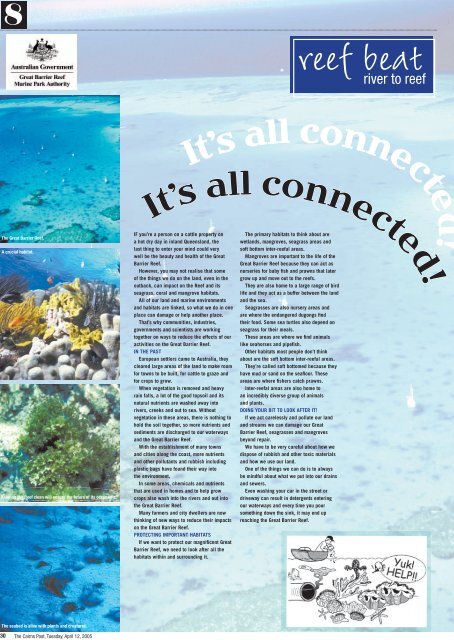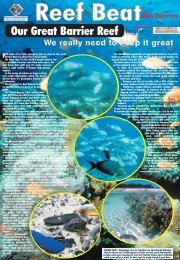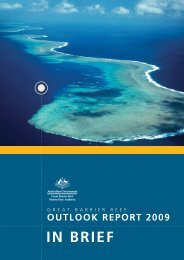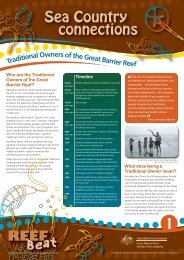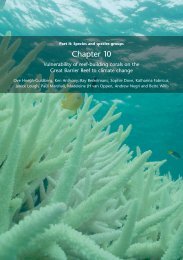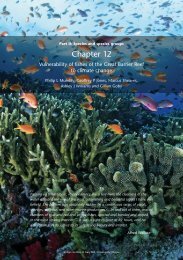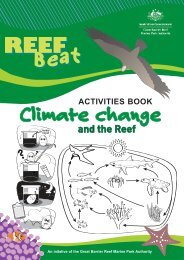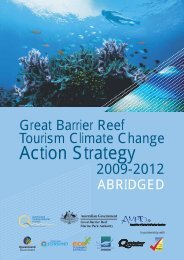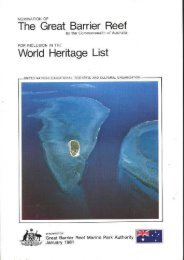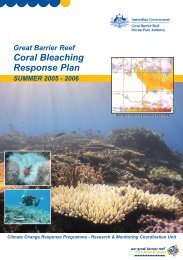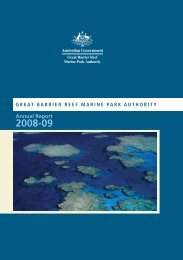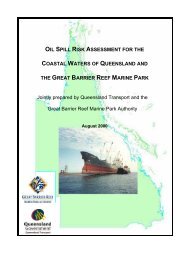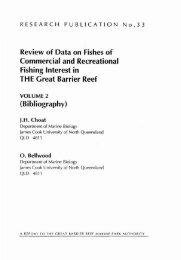8reef beatriver to reefconnected!all It’sThe <strong>Great</strong> <strong>Barrier</strong> <strong>Reef</strong>.A crucial habitat.Keep<strong>in</strong>g the <strong>Reef</strong> clean will ensure the future of its occupants.IF you’re a person on a cattle property ona hot dry day <strong>in</strong> <strong>in</strong>land Queensland, thelast th<strong>in</strong>g to enter your m<strong>in</strong>d could verywell be the beauty and health of the <strong>Great</strong><strong>Barrier</strong> <strong>Reef</strong>.However, you may not realise that someof the th<strong>in</strong>gs we do on the land, even <strong>in</strong> theoutback, can impact on the <strong>Reef</strong> and itsseagrass, coral and mangrove habitats.All of our land and mar<strong>in</strong>e environmentsand habitats are l<strong>in</strong>ked, so what we do <strong>in</strong> oneplace can damage or help another place.That’s why communities, <strong>in</strong>dustries,governments and scientists are work<strong>in</strong>gtogether on ways to reduce the effects of ouractivities on the <strong>Great</strong> <strong>Barrier</strong> <strong>Reef</strong>.IN THE PASTEuropean settlers came to Australia, theycleared large areas of the land to make roomfor towns to be built, for cattle to graze andfor crops to grow.When vegetation is removed and heavyra<strong>in</strong> falls, a lot of the good topsoil and itsnatural nutrients are washed away <strong>in</strong>torivers, creeks and out to sea. Withoutvegetation <strong>in</strong> these areas, there is noth<strong>in</strong>g tohold the soil together, so more nutrients andsediments are discharged to our waterwaysand the <strong>Great</strong> <strong>Barrier</strong> <strong>Reef</strong>.With the establishment of many townsand cities along the coast, more nutrientsand other pollutants and rubbish <strong>in</strong>clud<strong>in</strong>gplastic bags have found their way <strong>in</strong>tothe environment.In some areas, chemicals and nutrientsthat are used <strong>in</strong> homes and to help growcrops also wash <strong>in</strong>to the rivers and out <strong>in</strong>tothe <strong>Great</strong> <strong>Barrier</strong> <strong>Reef</strong>.Many farmers and city dwellers are nowth<strong>in</strong>k<strong>in</strong>g of new ways to reduce their impactson the <strong>Great</strong> <strong>Barrier</strong> <strong>Reef</strong>.PROTECTING IMPORTANT HABITATSIf we want to protect our magnifi cent <strong>Great</strong><strong>Barrier</strong> <strong>Reef</strong>, we need to look after all thehabitats with<strong>in</strong> and surround<strong>in</strong>g it.all It’s connected!The primary habitats to th<strong>in</strong>k about arewetlands, mangroves, seagrass areas andsoft bottom <strong>in</strong>ter-reefal areas.Mangroves are important to the life of the<strong>Great</strong> <strong>Barrier</strong> <strong>Reef</strong> because they can act asnurseries for baby fi sh and prawns that latergrow up and move out to the reefs.They are also home to a large range of birdlife and they act as a buffer between the landand the sea.Seagrasses are also nursery areas andare where the endangered dugongs fi ndtheir food. Some sea turtles also depend onseagrass for their meals.These areas are where we fi nd animalslike seahorses and pipefi sh.Other habitats most people don’t th<strong>in</strong>kabout are the soft bottom <strong>in</strong>ter-reefal areas.They’re called soft bottomed because theyhave mud or sand on the seafl oor. Theseareas are where fi shers catch prawns.Inter-reefal areas are also home toan <strong>in</strong>credibly diverse group of animalsand plants.DOING YOUR BIT TO LOOK AFTER IT!If we act carelessly and pollute our landand streams we can damage our <strong>Great</strong><strong>Barrier</strong> <strong>Reef</strong>, seagrasses and mangrovesbeyond repair.We have to be very careful about how wedispose of rubbish and other toxic materialsand how we use our land.One of the th<strong>in</strong>gs we can do is to alwaysbe m<strong>in</strong>dful about what we put <strong>in</strong>to our dra<strong>in</strong>sand sewers.Even wash<strong>in</strong>g your car <strong>in</strong> the street ordriveway can result <strong>in</strong> detergents enter<strong>in</strong>gour waterways and every time you poursometh<strong>in</strong>g down the s<strong>in</strong>k, it may end upreach<strong>in</strong>g the <strong>Great</strong> <strong>Barrier</strong> <strong>Reef</strong>.The seabed is alive with plants and creatures.30 The <strong>Cairns</strong> <strong>Post</strong>, Tuesday, April 12, <strong>2005</strong>
8Wetlands- an oasis of lifereef beatriver to reefWetlands arepeaceful placesof great beauty.WETLANDS are amaz<strong>in</strong>gand complex waterwaysthat occur <strong>in</strong> manydifferent sizes and forms.Wetlands are land areas eithertemporarily or permanently coveredby water. Types of wetlands <strong>in</strong>cludeswamps, marshes, billabongs,saltmarshes, mudflats, coral reefs,mangroves, lakes and peatlands.Mar<strong>in</strong>e habitats like coral reefs,seagrass meadows, mudflats,mangrove estuaries, samphire saltmarshes, rocky mar<strong>in</strong>e shores andsand or pebble beachesare common forms ofmar<strong>in</strong>e wetlands found<strong>in</strong> and around the <strong>Great</strong><strong>Barrier</strong> <strong>Reef</strong>.Wetlands are oftenareas of great beautywhere people enjoythe scenery and gatherfor recreation.In all their forms, wetlands arevery special places.THE IMPORTANCE OF WETLANDSWetlands <strong>in</strong> catchments alongthe coast next to the <strong>Great</strong> <strong>Barrier</strong><strong>Reef</strong> Mar<strong>in</strong>e Park are vital for thelong-term protection of the <strong>Great</strong><strong>Barrier</strong> <strong>Reef</strong>.Wetlands support a diverserange of mar<strong>in</strong>e life and providehabitat, breed<strong>in</strong>g and nurseryareas for birds, mammals, reptiles,amphibians, <strong>in</strong>sects and many fishspecies such as barramundi andmangrove jack.Wetlands play an important role<strong>in</strong> protect<strong>in</strong>g water quality <strong>in</strong> the<strong>Great</strong> <strong>Barrier</strong> <strong>Reef</strong> Mar<strong>in</strong>e Parkby help<strong>in</strong>g to filter the sediment,nutrients and other pollutants fromthe waters that enter the <strong>Great</strong><strong>Barrier</strong> <strong>Reef</strong>.They are also important <strong>in</strong>:• prevent<strong>in</strong>g erosion• allow<strong>in</strong>g sediments and nutrientsto settle out before enter<strong>in</strong>g the<strong>Great</strong> <strong>Barrier</strong> <strong>Reef</strong>• protect<strong>in</strong>g the coastl<strong>in</strong>e fromerosion and dur<strong>in</strong>g destructiveevents such as cyclones.Wetlands are significant habitatsfor Aborig<strong>in</strong>al and Torres StraitIslanders as part of their culturalheritage, spiritual values andday-to-day liv<strong>in</strong>g. Wetlands alsoprovide for recreational andtourism opportunities such asfish<strong>in</strong>g and guided tours.Wetlands on farms buffer theeffects of floods by hold<strong>in</strong>g excesswater for a short time, reduc<strong>in</strong>g theseverity of flood<strong>in</strong>g downstream.Wetlands provide diverse habitatsfor plants, birds and animals, manyof which feed on agricultural pests.Wetlands also make a farm a more<strong>in</strong>terest<strong>in</strong>g and pleasant place forpeople to work and live and theyprovide for added recreationalopportunities such as fish<strong>in</strong>g.WETLANDS IN DANGERMore than 50 per cent of ourwetlands have been significantlyaffected through degradation or losss<strong>in</strong>ce European settlement.Catchments adjacent to the<strong>Great</strong> <strong>Barrier</strong> <strong>Reef</strong> have beenextensively cleared and modifiedfor urban development, aquaculturedevelopment and agriculturalactivities such as cattle graz<strong>in</strong>gand cropp<strong>in</strong>g.PROTECTING WETLANDSThe protection of wetlands iscritical to help ensure the survivalof the <strong>Great</strong> <strong>Barrier</strong> <strong>Reef</strong>.The preservation andrehabilitation of wetland areas isa major environmental priorityfor the Australian and QueenslandGovernment’s <strong>Reef</strong> Water QualityProtection Plan.Communities, <strong>in</strong>dustries andgovernments are work<strong>in</strong>g togetherto raise awareness of the effects ofwetland clear<strong>in</strong>g and to help protectwetland areas for the future.A number of communityprojects have been developed tohelp prevent the decl<strong>in</strong>e of theseimportant environments.For <strong>in</strong>formation about how youcan become <strong>in</strong>volved <strong>in</strong> a wetlandprotection project <strong>in</strong> your area,contact your local Council or yourlocal Regional Natural ResourceManagement Group at http://regionalnrm.qld.gov.au/about/regional.DOING THEIR BIT TO LOOK AFTER ITMany communities andfarmers are work<strong>in</strong>g together torehabilitate and revegetate naturalenvironments like wetlands.By revegetat<strong>in</strong>g riverbanks,wetlands and other areas aroundtheir farms, land managers arehelp<strong>in</strong>g to decrease the amountof nutrients and sediments thatare discharged <strong>in</strong>to surround<strong>in</strong>gwaterways and <strong>in</strong> turn are help<strong>in</strong>gto improve the quality of water <strong>in</strong>the <strong>Great</strong> <strong>Barrier</strong> <strong>Reef</strong>.These actions will help to ensurethe survival of the <strong>Great</strong> <strong>Barrier</strong><strong>Reef</strong> and all of the habitats,plants, animals and <strong>in</strong>dustriesit supports.The wetlands are a haven for diversity.Mar<strong>in</strong>e life relies heavily on the prist<strong>in</strong>ewetlands for survival.30 The <strong>Cairns</strong> <strong>Post</strong>, Tuesday, April 19, <strong>2005</strong>


